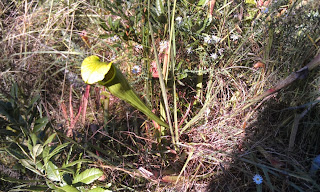Our primary purpose for flying to Virginia was to tour Colonial Williamsburg. We had both visited this historic area as children and it was on our bucket list of places to return. Within the Historic Area are 88 buildings that survived from the 1700's. More than 400 others have been reconstructed on their original sites. Colonial Williamsburg is a step back in time to the 18th century.
The Capital Building represents the original capital built in 1701. There are guided tours of this grand building. Every day at 2:00 The Declaration of Independence is read from the front lawn.
Most buildings are self guided. Costumed interpreters - tradespeople, housewives, slaves, freemen, governmental officials and soldiers, go about their everyday duties.
Since we visited Colonial Williamsburg on three separate days, we were able to enjoy lunch at three different Tavern eateries. Each having a unique traditional homemade fare. This one is Chowning's Tavern.
When the Governor's Palace was completed in 1722, it was the residence of Virginia's Royal governor. It was considered one of the finest structures in America.
The Palace grounds has an elaborate garden with flowers, greenery, arbors and a Garden Maze which we particularly remember from our childhood.
Everyday at 4:30 there is a fife and drum fan fair and cannon salutes. The crowd is addressed in preparation for the "siege of Yorktown".
Bruton Parish Episcopal Church was completed in 1715. The bell tower contains The Tarpley Bell cast in 1761 and it still rings for services. High back pews with doors were typical of unheated eighteenth-century English churches. The names on the pew doors are parish leaders and famous patriots who worshipped here, including U.S. presidents Washington, Jefferson, and Monroe. Since this is still an active church, we were privilaged to attend Sunday evening service.
The King's Arms Tavern was another favorite lunch stop. We enjoyed delicious chicken pot pie and traditional desserts.
The Public Gaol, built in 1704 once housed 15 notorious pirates of Black Beard and Henry "Hair Buyer" Hamilton who paid a bounty for Patriot scalps.
 |
| Public Stocks were a popular form of punishment for misdemeanors. |
Williamsburg is one point of the Historic Triangle with Jamestown ten miles southeast and Yorktown 13 miles southwest.
Historic Jamestowne along with the James River was named after King James I of England. This was America's first permanent English colony established in 1607. This is a National Historic Park, administered by the National Park Service. Original foundations reveal the footprint of the fort and structures. There is also an Archaearium Museum that displays over a million artifacts that have been excavated from the site. We also took the five mile Island Drive Auto Tour.
John Smith and 103 Englishmen endured a five month sea passage to reach the shores of Virginia in 1607. If not for the daughter of the Chief of the Powhatan Indian tribe, Pocahontas, they would have perished. Even at that, less than a third survived the first year.
Near the reconstructed glass furnace are the ruins of Jamestown's first glass furnace, all that remain of the colony's dream of a livelihood from glass making. When tobacco was introduced as a cash crop around 1613, the colony finally began to prosper.
Jamestown Settlement, next to Historic Jamestowne, is a commercial recreation of the English Fort, a Powhatan village and a museum.
We climbed aboard replicas of the 17th century sailing ships, the Discovery, Godspeed and Susan Constant, which are moored on the James River.
Yorktown is best remembered for the Siege of Yorktown which effectively ended the Revolutionary War when General Cornwallis surrendered to General George Washington and Marquis de Lafayette.
This is the Yorktown Victory Monument which commemorates the allied victory over Cornwallis in 1781.
Yorktown came under siege again in the spring of 1862 when Union General McClellan began his campaign to capture Richmond the capital of the Confederacy.
Yorktown Victory Center, next to Yorktown battlefield, is a commercial exhibit and museum of the American Revolution. Kurt volunteered to participate in loading the cannon for a firing demonstration.






















































